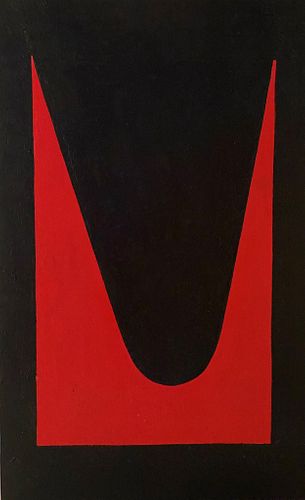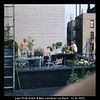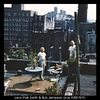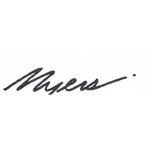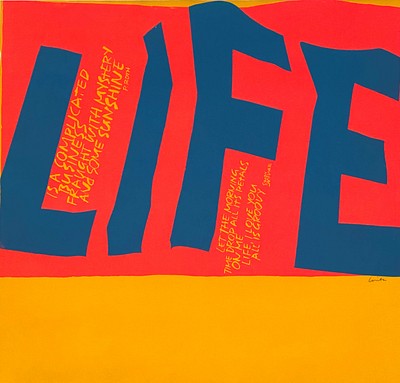Leon Polk Smith (Am. 1906-1996) Red Black Painting
Two ways to bid:
- Leave a max absentee bid and the platform will bid on your behalf up to your maximum bid during the live auction.
- Bid live during the auction and your bids will be submitted real-time to the auctioneer.
Bid Increments
| Price | Bid Increment |
|---|---|
| $0 | $10 |
| $100 | $25 |
| $500 | $50 |
| $1,000 | $100 |
| $2,500 | $250 |
| $5,000 | $500 |
| $10,000 | $1,000 |
| $15,000 | $2,500 |
| $50,000 | $5,000 |
| $100,000 | $10,000 |
About Auction
Apr 30, 2023
Fine Art Auction - 35th Anniversary Myers Antiques auctions@myersfineart.com
- Lot Description
Leon Polk Smith (American, 1906-1996) Painting. Red on Black 1956 painting. Oil on canvas painting laid down on plywood. Inscribed on the reverse Leon Polk Smith 1956 and also repeated in pencil. Measures 25.75 inches high, 16 inches wide. The painting is from the personal collection of Leon Polk Smith's partner and assistant, Robert Jamieson. A signed letter of provenance from Leon Polk Smith's life partner and assistant, Robert Jamieson (1926-2020) will be included with the painting along with a Leon Polk Smith exhibition catalog and photo of Leon in his New York studio. In good condition.
From AskArt: The power in the art of Brancusi and Mondrian had an early and profound effect on Leon Polk Smith who became one of the leading American non-objective color-field precisionists. Smith's success lied in his ability to create works which had a simple, colorful hard-edge presence. His strongest examples of these artistic tenets can be found in his Constellation Series, beginning in 1967. Native American born artist Leon Polk Smith came to New York City, at 30 years of age, in 1936 to study at Columbia University's Teachers' College. The young artist began his career depicting subjects inspired by life in Oklahoma and New York in an amalgam of Surrealist and Expressionist styles. The power of Brancusi and Mondrian's art was ultimately irresistible to Smith, and in 1945, he began to explore the formal problems inherent in the creation of non-objective art. Smith shared Mondrian's affection for New York, writing in 1989: "New York City revealed its physical self to me through the mountains and canyons of the Southwest. There were the ups and downs--the high peaks, the in-betweens, or the canyons, and topped with the great dome... I felt the city to be a perfect equation for a great abstraction." The New York experience was a turning point, and he never looked back. His genius in extending the boundaries of the available geometric tenants truly took hard-edge minimalism to the next level. His free-hand approach, use of diagonals and circles and the abandonment of the European geometricians' grids would "re-invent the purpose of geometric abstraction”. Smith's work is including in the permanent collections of numerous museums including the Guggenheim, the Whitney Museum of American Art, and the National Gallery of Art. LEON POLK SMITH - Addison Parks, 1985; Courtesy ARTS Magazine Leon Polk Smith admits to being one of the twice born; art too claims its converts. Seated in his New York apartment, which also hosts his studio, he speaks softly and serenely of the life art has shared with him. The air is surprisingly fresh and relaxed, it doesn't feel like New York. His living room is cool and bright from a crossfire of east and west exposures, high up they overlook Union Square on one side and face a cathedral of water towers on the other. Only Smith's paintings dress the walls, and they light the room with an elegance which is betrayed only by their jaunty and jubilant spirit. He explains that while he is an ardent art enthusiast, all of his ideas come from his own works, and they serve him well by being where he can look at them. He speaks with a gently rhythmic but a touch crusty southwestern accent, and there is still a shadow of the rugged frontier about him, which can be traced back to his work. I discovered art my last year in college ... 1934. Having grown up in Oklahoma and having been older than the state, there wasn't much art there. So I was still younger than I was at college age, and I had never seen an original painting. I don't think I knew anyone very well who even had art in their vocabulary. And it's quite by accident that I discovered art. That last year, I was in a building I had never been in before, walking down the hall, looking into the rooms as I passed. . . and this room had students and they were painting and drawing. And somehow that fascinated me immediately. I thought: I wish I could do that. And l went in and asked the instructor if I could come in and work for the rest of the term. He said yes. I think I realized very quickly that I had always been an artist, and that that was what I wanted. That I would always keep it for myself, that I would never prostitute it, or do anything with it just for money. I had prepared to be a teacher. When I started school, I said, I want to be a teacher, and it never entered my mind.... Even after I discovered art, and said I was going to be an artist, I knew that to make a living I would do what had been my first choice, which was teaching. I taught for about twenty-five years. After I finished college, and taught one year, I came to New York in 1936 to study at Columbia ... get my Masters ... education and psychology. I knew I wasn't going to start selling paintings (he laughs). Paintings didn't start selling to somehow support me until about 1957. That's when I stopped teaching. From the awesome horizontality of the Oklahoma plains to New York's concrete peaks and valleys, Smith's one preoccupation has been space. From the late thirties through the early fifties it was the Constructivist space of Mondrian which dominated his scope: pure rectilinear abstraction with a parity of positive and negative form. Like many others working under the mast of Constructivism, Smith was looking for the next step up, a stage further in the evolution. Some painters pursued lyrical abstraction, but these solutions sat too self-centered to excite him. So he pushed on. When I discovered this thing in 1954, dividing a canvas into two areas, painting in two colors, I did about twelve to fifteen tondos before I was able to carry the idea over into the rectangle. Because I discovered the idea on a circular format, you know I must have told you about seeing this athletic catalog ... the illustrations that were done that were pencil drawings rather than photographs, of a baseball, tennis ball, football ... that came into my studio, that was in the mail. I don't know why it was sent to me ... found myself going through the catalog ... looking through the drawings. I certainly was not interested in any of them as a baseball or a basketball, but I was looking. And I thought, what the hell am I doing this for, why am I looking at this ? And a little voice says, because that's what you're looking for ... that excited me and l knew immediately what it meant. I rushed into my studio, got some paper and a compass and started drawing circles and dividing them up. Then I had to start inventing my own break up. I was inspired. Because that presented what was I looking for? When Mondrian died, I think 1945, people said he had hit a dead end, or a stone wall and I said I don't think so. There is no such thing as a stone wall except in one's mind. I said to myself, I think it would be wonderful to use his great discovery of the interchange of elements of form and space, or background-- foreground, although he only used it at a direct angle or a straight line--if one could find a way of using that in curvilinear form-and that's what I was looking for, all through the forties ... I certainly wouldn't have gone to an athletic catalog to find it, but that's where I found it. Of course the shapes and lines were very limited, and immediately had to start finding my own, which I did. But then that created a space there that I had never seen in painting before. It was flat and at the same time it was curved. It was like a sphere. The planes seemed to move in every direction, as space does. And so I thought, maybe that is because that's on the tondo. I've got to find out if that is true or not. I've got to do some on a rectangle to see if the form and the space still moved in every direction. And it did. So it was exciting to do a painting on a rectangle that seemed to have a curved sur-face. It was the first time, you see, that I had made an important step myself, or contribution in art. Color and shape are the converging planes which form the fulcrum over which Smith see-saws his space. They form the language of which he is a master. Color and shape are his domain; the crossbars of his scope; his words. With them he writes poetry; poems which magnificently sweep their time and space into a single gesture. In space there is no up or down; up here is down there on the other side of the globe. Smith enlarged the concept of space in painting to meet with the twentieth century, everything moves at a diagonal. He first started experimenting with this in the rectilinear Constructivism of the forties; he implied lines which moved diagonally between points. Later he exposed the diagonals and still maintained a vocabulary of implied lines. Both are central to his dialogue, especially today. In the multiple panels Smith takes the concept of positive/negative parity one step further. He invites the surrounding space into the experience, and activates it into an equal exchange. The painting becomes a point of departure - a runway into space. We sense the awe in this work, and wonder. These latest paintings are of a dimension so large, so fast and so deep, they tower like futurist space machines, seeming to pulsate on the threshold of infinity. Smith constantly talks of excitement as though it were an essential. He has a faith in what art can do, and be, and this is supremely evident in his work; so much so that with it he restores even our doubt in the doubt intrinsic to both. . . . isn't it simply wonderful to be able to paint? That's what I wanted to do. Now I can - It's something I would pay to do, if I were able to, if I had to.Condition
Condition is listed in the description
- Shipping Info
-
All shipping arrangements and costs are the sole responsibility of the buyer. We are happy to assist in the transfer of merchandise to a shipper of your choice. Buyers should request a shipping quote prior to bidding. There are reliable shipping companies to use, and they include:
(1) The UPS Store:
Charlie Mosher
301 West Platt St
Tampa, FL 33606
(813) 251-9593
store3751@theupsstore.com
www.theupsstore.com/3751For a shipping quote, click the link below to get started on a quote OR to make payment for an existing quote: MyAuctionQuote.com/myers
(2) The UPS Store:
RayAnna Brodzinski
740 4th Street North
St. Petersburg, FL 33701
(727) 513-2400
shipping@store6886.com
www.theupsstore.com/6886(3) The UPS Store:
Rian Fehrman
5447 Haines Rd N,
St. Petersburg, FL 33714
(727) 528-7777
store6173@theuspsstore.com
www.theupsstorelocal.com/6173(4) Family Pak & Ship
Amel & Mohamed Hamda
2822 54th Avenue S.
St. Petersburg, FL 33712
727 865-2320
Raman@familypakandship.com
www.familypakandship.com(5) The UPS Store:
Gina Farnsworth
204 37th Ave N.
St Petersburg, FL 33704
(727) 822-5823
store3146@theupsstore.com
www.theupsstore.com/3146(6) The UPS Store:
200 2nd Ave South
St Petersburg, FL 33701
(727) 826-6075
store3248@theupsstore.com
www.theupsstore.com/3248(7) Craters & Freighters
(813) 889-9008
Fax (813) 884-8393
Tampa@cratersandfrighters.com
www.cratersandfreighterstampa.com (U.S. & International)(8) Orbit Professional Packing Crating
(888) 247-8540 or (727) 507-7447
lg@orbitppc.com
www.orbitppc.com (U.S. & International)LARGER ITEMS SHIPPING SUGGESTIONS
For items too large for standard shipping, such as furniture:
(1) Plycon - Furniture Transportation Specialists"
(954) 978-2000 (U.S. only)
lisa@plycongroup.com
www.plyconvanlines.com
You must submit a request on-line.(2) All Directions Moving
Specialist in moving furniture from FL to NY.
941-758-3800
alldirections@comcast.net
(3) Craters & Freighters
(813) 889-9008 or (877) 448-7447
Tampa@cratersandfreighters.com
(U.S. & International).(4) Westbrook Moving LLC
Makes regular trips up and down the east coast.
(404) 877-2870
westbrookdeliveries@gmail.com(5) Eastern Express
Owner Jeff Bills makes regular trips up and down the east coast.
(843) 557-6633
jb101263@yahoo.com(6) Can Ship US
Owner makes trips from Florida to Canada
Steve Fleury (905) 301-4866
canshipus@gmail.comThere are many other local and national shippers available in our area that we can refer you to. We are not responsible for any delays on the part of this third party shipper, should there be any. We recommend shipping all items insured. Should any damage occur to items transported by a third party, we are not held responsible. In the event that an item is approved for a return, shipping is not refundable.
-
- Buyer's Premium



 EUR
EUR CAD
CAD AUD
AUD GBP
GBP MXN
MXN HKD
HKD CNY
CNY MYR
MYR SEK
SEK SGD
SGD CHF
CHF THB
THB